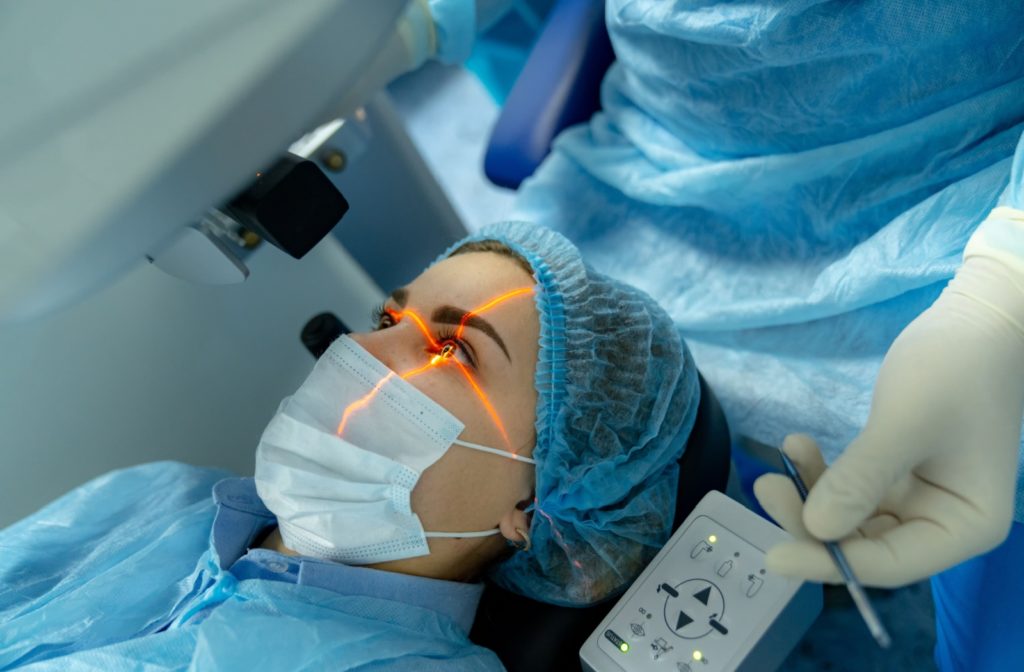Myopia, more commonly called nearsightedness, is extremely common. This condition affects millions of Americans every year, causing blurry vision, strain, and more. Fortunately, you don’t need to suffer in silence; your optometrist can help through myopia control and treatment. So how is myopia treated?
There are 5 key myopia treatments that can help:
- Atropine eye drops
- Multifocal contact lenses
- Orthokeratology
- Eyeglasses and contacts
- Corrective surgery
What Is Myopia?
The human eye is incredible, relying on a carefully balanced system to give you the gift of vision. When light enters a normal eye, it’s refracted by the cornea and lens, focusing the image directly on the retina at the back of the eye. There, the retina can send the image to the brain through the optic nerve, and you can see.
However, this entire system relies on the eye being shaped properly. In an eye with myopia, the shape is elongated, or the cornea is curved incorrectly, causing a refractive error. Light doesn’t focus where it needs to; instead, it focuses in front of the retina and scatters. This leads to blurriness the further away an object gets from your eye.
Typically, myopia develops in early childhood. It’s progressive, so as you grow, vision tends to worsen until the eye stops developing around the age of 20.
However, it’s not just about blurry vision and inconvenience. As the eye elongates, the physical structure changes, which can increase the risks of conditions like retinal detachment and cataracts later in life. This is why myopia control and treatment are so essential.
How to Treat Myopia
Myopia control aims to intervene as a child grows to adjust how their eye develops over time. This process begins with a visit to your optometrist; there, they can examine your child’s eye to determine the right approach.
Then, one of the following will be suggested:
- Atropine eye drops
- Orthokeratology
- Multifocal contact lenses
Atropine Drops
Atropine eye drops are a safe and effective way to slow down myopia progression. These drops temporarily paralyze the focusing muscles in the eye, which can affect the signals that control the eye’s growth.
Typically, this is done using a very low concentration of atropine—around 0.01% or so. Ideally, these drops should be used nightly, and in coordination with another method of myopia control.
Multifocal Contact Lenses
Multifocal contact lenses, also known as dual-focus lenses, are specially designed with a dual purpose in mind:
- To correct refractive errors and give clear vision
- To slow myopia progression
These lenses have different focusing powers within the same lens. Think of a bullseye—a clear central area with rings extending outwards. These lenses are built similarly—each ring has a different focusing power.
When light enters these rings, some light goes directly to the retina to correct your natural refractive error, while other light rays are sent elsewhere. This forces a state called peripheral defocus, which signals your eye to slow down its rate of elongation.
Orthokeratology
Orthokeratology, or ortho-k, is another contact lens-based approach but utilizes a different strategy. This non-invasive method involves the use of specially designed rigid gas-permeable lenses overnight.
These lenses apply gentle, subtle amounts of pressure to the edge of the cornea. While a child sleeps, this pressure slowly pushes the eye to a more desirable shape, accommodating the elongation of the eyeball and making it much easier to properly refract light.
Then, when your child wakes up, the lenses are removed, and the eye retains this new shape throughout the rest of the day. This means they’ll have clear vision without the need for eyeglasses or other contact lenses! As the day ends, their eye will slowly revert to the natural myopic shape, and they can re-use the lenses overnight for the next day,
It’s important to note that the results of ortho-k are temporary and require your child to use the lenses every night. If your child stops using the lenses, their eyes will revert to their natural shape, and they’ll continue experiencing blurry vision until they restart treatment.
Eyeglasses & Contacts
While myopia control methods can be effective, there is bad news—once your eye stops developing, they’re no longer as effective.
For adults living with myopia, you can easily get help for your vision by visiting your optometrist to discuss eyeglasses and contact lenses. These lenses aim to correct and redirect light as it enters the eye. By changing the angle of the light, these lenses can target the retina, giving you clear vision as long as you wear them.
However, it’s important to note that while these are both excellent approaches to correcting vision, they don’t address the underlying causes of myopia or slow down its progression—they’re designed to only provide results for as long as you wear them.

Laser Eye Surgery
For adults looking for a more permanent solution to their myopia, laser eye surgery could be the answer. This can be an extremely effective answer, but it’s important to note that there are a few restrictions.
To qualify for laser eye surgery, you need to:
- Have stable vision for at least a year. This means your prescription shouldn’t have changed significantly in the recent past.
- Be at least 18 years old, though some doctors recommend waiting until your mid-20s when your vision is more likely to have stopped changing.
- Have corneas that are thick enough for the surgery. This is crucial as the procedure involves reshaping the cornea with a laser.
If your optometrist determines you to be a suitable candidate, they’ll be able to walk you through the entire process. This procedure aims to change the shape of your cornea so it can properly refract light without needing corrective lenses. This is a permanent result, and most people notice clearer vision within 24 hours or so.
However, it’s important to remember that not everybody is a candidate for laser eye surgery. You’ll need to book a laser eye surgery consultation and speak with your optometrist.
Where to Get Help for Myopia
Myopia can be a significant inconvenience, but you don’t need to deal with it alone. Whether you or your child are dealing with this condition, come talk to our team at Total Vision Tierrasanta. We can help find the right solution for your unique situation. You deserve clear vision, so book an appointment with us today!


